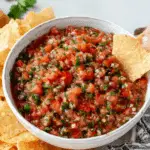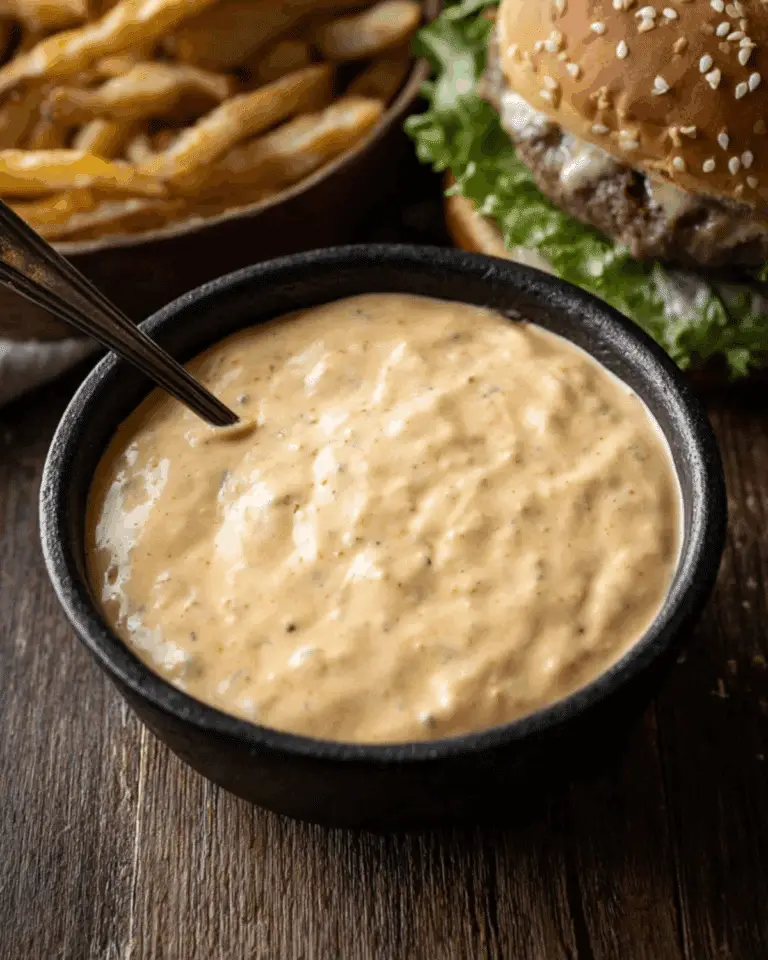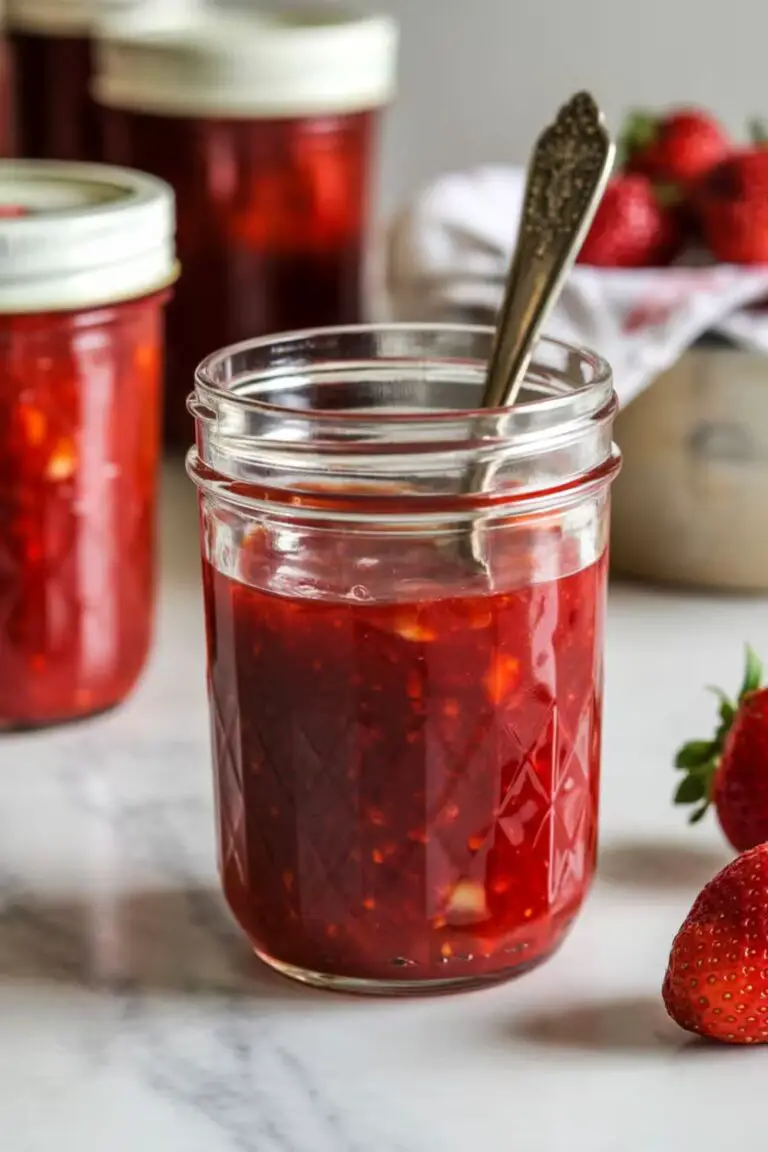Looking to spice up your summer with a vibrant dip that’s full of bold, zesty flavors? This homemade salsa recipe with fresh tomatoes is your go-to guide. Whether you’re prepping for taco night, a backyard BBQ, or simply snacking with chips, nothing compares to the flavor of salsa made with ripe garden tomatoes, crisp onions, and fresh herbs. In this article, you’ll learn why fresh tomatoes are essential, how to choose the right ingredients, and the exact step-by-step process to make salsa that tastes restaurant-quality—right from your blender or food processor. Check out our blender salsa recipe for a different smooth and spicy twist!
JUMP TO
Table of Contents
The Secret to the Best Homemade Salsa
Why Fresh Tomatoes Make All the Difference
Using fresh tomatoes instead of canned gives salsa a naturally sweet and juicy base. The flavor is lighter, brighter, and far more layered. Canned tomatoes often carry added preservatives or a metallic aftertaste, which can dull the flavor of your dip. Fresh tomatoes offer a refreshing, farm-to-table experience in every bite.
Roma, Vine-Ripe or Heirloom? Choosing the Right Tomato
Roma tomatoes are the gold standard when it comes to salsa. They have firm flesh, fewer seeds, and less moisture—perfect for a thick, scoopable consistency. Vine-ripe and heirloom varieties also work wonderfully if you don’t mind a bit more juiciness. A mix of types can deepen the flavor profile. Learn more about tomato-based dips in our fire roasted salsa recipe.
The Role of Acidity, Sweetness & Spice in Salsa Balance
Balancing acidity from lime juice with a pinch of sugar cuts through the richness and lets each flavor shine. Spice from jalapeños or serrano peppers should complement, not overpower. Garlic, onion, and cumin deepen the base while cilantro adds freshness. Together, these elements bring life to a simple tomato base.
Must-Have Ingredients for Flavor-Packed Salsa
Fresh vs. Store-Bought: Ingredients That Elevate Your Salsa
You don’t need fancy or exotic ingredients to create a flavorful salsa. The magic lies in freshness. Always opt for:
- Fresh tomatoes (preferably Roma or garden-grown)
- Crisp yellow and green onions
- Aromatic garlic
- Fragrant cilantro
- Lime juice for brightness
Store-bought options often use dried herbs or citric acid, which don’t compare. Discover great ideas like our homemade salsa for canning if you’re preserving large batches.
Herbs, Citrus, and Heat: Cilantro, Lime & Jalapeños Explained
Fresh cilantro adds herbaceous, citrusy notes that cut through the tomato sweetness. Lime juice boosts brightness, while jalapeños control the heat. For more spice, include the seeds; for mild versions, remove them or reduce the quantity. Adjusting these allows you to customize salsa based on your crowd.
Pantry Staples: Salt, Cumin, and Sugar—What They Add
- Salt: Enhances overall taste
- Cumin: Brings a smoky, earthy undertone
- Sugar: Balances acidity from tomatoes and lime
Adding just a pinch of each goes a long way. Start small, blend, taste, and adjust. This way, your salsa hits every note without overwhelming the palate.
How to Make Homemade Salsa Step-by-Step
Prep Like a Pro: Washing, Chopping & De-Seeding
Cleanliness and prep are crucial. Wash all produce thoroughly. Core and deseed the tomatoes to prevent watery salsa. Roughly chop onions, garlic, jalapeños, and herbs to make blending smoother.
| Ingredient | Prep Tip |
|---|---|
| Tomatoes | Core and remove seeds |
| Jalapeños | Remove seeds for less heat |
| Onions | Chop roughly |
| Garlic & Cilantro | Mince or tear for quick blending |
Blending Techniques: Chunky vs. Smooth Salsa Styles
Add all ingredients to a food processor or blender. Pulse lightly for chunky salsa or blend longer for a smoother consistency. Don’t over-blend—it should be scoopable, not soupy.
Looking for inspiration? Try our chicken tacos with grilled pineapple salsa that pairs perfectly with this salsa.
Chilling Time: Why Resting Brings Out the Best Flavors
Once blended, let your salsa rest in the fridge for 1–2 hours or overnight. This allows all the flavors—acidic, sweet, salty, and spicy—to meld beautifully. It’s tempting to dive in, but that wait makes all the difference.
Don’t miss our tomato cucumber and onion salad for another tomato-based summer favorite.
Expert Tips for a Better Salsa Every Time
Common Mistakes to Avoid (and How to Fix Them)
Making salsa seems easy—just blend ingredients, right? But there are a few mistakes that can ruin the flavor or texture:
- Over-blending: This can turn your salsa into soup. Pulse instead of blend fully.
- Using watery tomatoes: Tomatoes with too many seeds or juice (like beefsteaks) can make your salsa runny. Stick to Roma or strain excess liquid.
- Over-salting: Salt amplifies flavor, but too much kills freshness. Start light and adjust after chilling.
- Skipping chill time: Salsa straight from the blender tastes flat. Chill for 1–2 hours so flavors can marry.
If you’re struggling with thin consistency, simply strain the salsa with a fine mesh strainer or chill it uncovered to evaporate excess moisture. Don’t miss our Mexican potatoes recipe—a perfect side dish to enjoy with homemade salsa!
How to Adjust Spice Level Without Losing Flavor
Love heat? Keep jalapeño seeds in or add serranos. Prefer mild? De-seed the peppers and use just half. Need to fix a salsa that’s too spicy? Add more tomatoes, a pinch of sugar, or avocado to mellow things out without losing texture or flavor.
To build layers of flavor instead of overwhelming spice, consider roasting jalapeños for a smoky depth or try using a small dash of chipotle powder.
Storage, Freezing & Shelf-Life Tips for Fresh Salsa
Your homemade salsa can be stored in an airtight glass jar or container in the fridge for up to 7 days. Always use a clean spoon to avoid introducing bacteria.
Can you freeze it? Yes! While fresh salsa can be frozen, it may lose its texture and become watery once thawed. To avoid that, strain before freezing and re-blend after defrosting. Or use frozen salsa in soups or cooked dishes like chili or taco meat.
Salsa Variations You Should Try
Roasted Tomato Salsa vs. Fresh Salsa
Roasting tomatoes, garlic, and peppers before blending gives salsa a smoky, rich flavor. It’s a deeper and more savory experience compared to the bright, zesty punch of raw tomato salsa.
Fresh tomato salsa is best when you want a light, garden-fresh flavor with citrusy zing. Roasted versions are perfect for fall meals, cozy gatherings, or smoky meats. Discover great ideas like our fresh peach cobbler that complements spicy dishes beautifully.
Pico de Gallo vs. Salsa: What’s the Real Difference?
People often confuse these two. Pico de gallo is a type of salsa made with chopped raw tomatoes, onion, jalapeño, cilantro, and lime—served fresh and chunky.
Blended salsa, like the one in this recipe, combines the same ingredients but in a smoother, more sauce-like consistency. Blending helps flavors combine and allows the salsa to cling better to chips or spread more evenly on tacos.
Both are delicious, but your choice depends on whether you want something scoopable and juicy or smooth and dippable.
Fun Twists: Mango, Peach, or Avocado Add-Ins
If you want to get creative, try mixing in chopped mango or peach for a fruity, tropical vibe. Or, add avocado chunks for creaminess and extra nutrition.
Here are a few flavor combinations to try:
| Twist | What to Add | Flavor Notes |
|---|---|---|
| Mango-Lime Salsa | Mango + lime zest | Sweet, citrusy, bright |
| Avocado Salsa | Avocado + extra garlic | Creamy, mellow |
| Peach-Jalapeño | Peach + chili flakes | Sweet heat |
| Chipotle-Corn | Chipotle + charred corn | Smoky, earthy |
These variations not only elevate your salsa game but also impress guests and complement a wide range of dishes.
Serving Ideas: Beyond Just Chips
Salsa Pairings: Nachos, Tacos, Eggs & More
Yes, chips and salsa are a classic—but don’t stop there. Use your homemade salsa with fresh tomatoes in all kinds of dishes:
- Over nachos with melted cheese and black beans
- Inside tacos or burritos for added moisture and punch
- Spoon onto scrambled eggs or breakfast quesadillas
- Top grilled chicken or salmon for a zesty finish
- Mix into taco bowls or grain bowls for added flair
For a bright and colorful breakfast, check out our watermelon fruit salad alongside your morning eggs and salsa.
Entertaining with Salsa: Potlucks, BBQs & Game Days
Salsa is the MVP of any party spread. Make a large batch, store it chilled, and bring it to potlucks or tailgates. Pair with other dips, guacamole, and a side of margaritas. For variety, create a salsa bar with multiple spice levels and mix-ins.
Want to go further? Use mini mason jars for individual servings—hygienic and stylish.
Creative Uses: Grilled Meats, Burrito Bowls & More
Use salsa as:
- A base for taco meat seasoning
- A marinade for grilled chicken or shrimp
- A topping on baked potatoes
- An alternative to ketchup on burgers
- A bright sauce for grilled tofu or vegetables
The versatility of salsa is unmatched. Once you have a reliable homemade version, you’ll find ways to use it every day.

Frequently Asked Questions (FAQs)
How long does homemade salsa last in the fridge?
When stored in an airtight container, homemade salsa will stay fresh in the fridge for up to 7 days. Always use a clean spoon when scooping to avoid contamination.
Can I freeze fresh tomato salsa?
Yes, you can. However, freezing may change its texture slightly. For best results, strain any excess moisture before freezing and blend again after thawing. Frozen salsa works well in soups or cooked dishes.
Why is my salsa too watery and how can I fix it?
This usually happens with overly juicy tomatoes or not seeding them properly. You can fix watery salsa by straining it through a fine mesh sieve or letting it chill uncovered in the fridge to thicken.
What’s the best way to preserve salsa for later?
If you’re looking to preserve your salsa for months, try a canning method. It requires sterilized jars and a boiling water bath to seal the salsa. Check out our homemade salsa for canning guide for step-by-step instructions.
How do I make salsa less spicy without ruining the taste?
Simply reduce the number of jalapeños, remove their seeds, and balance the heat by adding more tomatoes or a touch of sugar. You can also mix in diced avocado or mango to mellow the spice while adding flavor.
Conclusion: A Fresh, Flavorful Salsa Worth Sharing
There’s something magical about making your own homemade salsa recipe with fresh tomatoes. The bright, zesty flavors, the crispness of fresh herbs, and the customizable spice level make it a must-have recipe in every kitchen. Whether you’re using it as a dip, a topping, or a marinade, this salsa adds a burst of summer freshness to every bite. Ready to try more salsa combos? Don’t miss our easy fire roasted salsa and other flavorful pairings. Keep experimenting, taste-testing, and sharing with friends—because once you make this salsa, you’ll never go back to store-bought again.
PrintDelicious Homemade Salsa Recipe with Fresh Tomatoes
This homemade salsa recipe with fresh tomatoes is bright, zesty, and bursting with fresh flavor. It’s perfect for dipping, topping tacos, or spooning over grilled meats.
- Prep Time: 15 minutes
- Cook Time: 0 minutes
- Total Time: 1 hour 15 minutes (including chilling)
- Yield: 6 servings
- Category: Dip, Appetizer
- Method: Blended
- Cuisine: Mexican
- Diet: Vegan
Ingredients
- 1 1/2 pounds Roma tomatoes, cored and quartered
- 1/2 medium yellow onion, roughly chopped
- 1 green onion, ends trimmed
- 2-3 cloves garlic, finely chopped
- 2 jalapeños, diced (with seeds if you like heat)
- 1/2 cup fresh cilantro
- Juice of 1/2 lime
- Pinch of cumin
- Pinch of sugar
- Salt, to taste
Instructions
- Prepare the vegetables: core and deseed the tomatoes, roughly chop onions, garlic, and jalapeños.
- Add all ingredients to a food processor or blender.
- Pulse until desired consistency is reached (chunky or smooth).
- Taste and add salt as needed.
- Chill the salsa in the fridge for 1–2 hours to allow the flavors to develop.
- Serve with chips, on tacos, or as desired.
Notes
- Use Roma tomatoes for a thicker, less watery salsa.
- De-seed jalapeños for less heat.
- Don’t over-blend to avoid a soupy texture.
- Refrigerate salsa before serving to enhance the flavors.
- Use a fine mesh strainer if salsa becomes too watery.
Nutrition
- Serving Size: 1 serving (based on 6)
- Calories: 31
- Sugar: 0.9g
- Sodium: Varies by salt added
- Fat: 0.4g
- Saturated Fat: 0.1g
- Unsaturated Fat: 0.3g
- Trans Fat: 0g
- Carbohydrates: 6.7g
- Fiber: 1.7g
- Protein: 1.2g
- Cholesterol: 0mg








